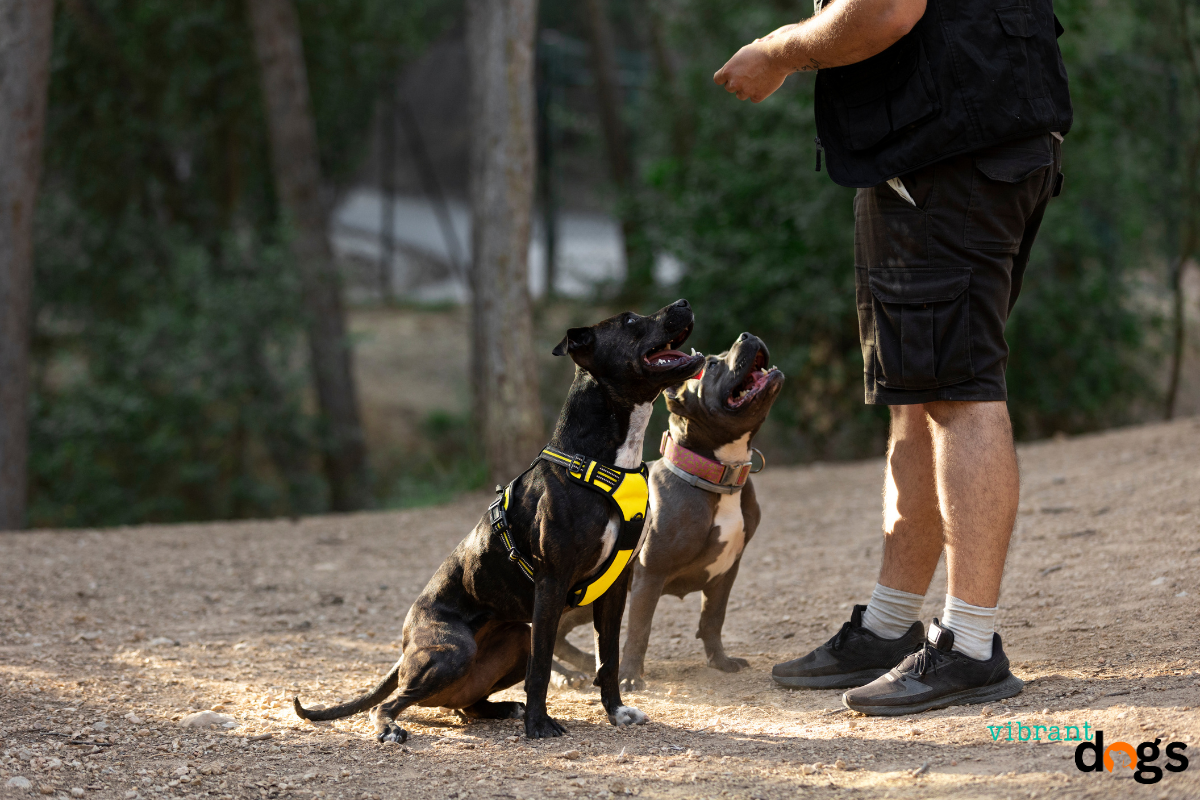Imagine a world where your dog is more than just a pet. They become a key partner in your daily life. Service dog training makes this dream a reality. It turns your furry friend into a trusted helper, improving your life greatly.
Service dogs are amazing animals. They are trained to help people with many disabilities. These dogs learn special tasks, making them essential for their owners. They offer independence, security, and the courage to overcome any challenge.
Key Takeaways
- Service dog training unlocks the potential of your furry friend to become a reliable helper.
- Service dogs are trained to assist individuals with a variety of disabilities, enhancing their independence and quality of life.
- Mastering specialized tasks and behaviors is the key to transforming your dog into a service companion.
- Proper training and certification are essential to ensure your service dog is equipped to handle public settings and provide the necessary support.
- With dedication and the right approach, you can cultivate a strong bond and trust with your service dog, empowering you to face life’s challenges with renewed confidence.
Understanding Service Dogs: Roles and Responsibilities
Service dogs are crucial for people with disabilities. They offer vital help and support. These dogs are trained to do many tasks, helping their owners live better lives.
They guide the blind, alert those with hearing loss, and more. Service dogs are true partners in empowerment.
Types of Tasks Service Dogs Perform
Service dogs can do amazing things. They help in many ways, such as:
- Retrieving dropped items
- Opening and closing doors
- Turning on and off lights
- Detecting seizures or changes in blood sugar levels
- Guiding individuals with visual impairments
- Providing balance and mobility assistance
- Interrupting and preventing self-harming behaviors
Legal Rights and Public Access
Service dogs and their handlers have special rights. The Americans with Disabilities Act (ADA) lets them go anywhere, like restaurants and stores. This means people with disabilities can join in community activities and enjoy the same freedoms as others.
Difference Between Service Dogs and Therapy Animals
It’s key to know the difference between service dogs and therapy animals. Service dogs are trained to help with disabilities. Therapy animals, on the other hand, offer comfort and support to many people, often in healthcare or schools.
| Service Dogs | Therapy Animals |
|---|---|
| Trained to perform specific tasks to mitigate a disability | Provide comfort and emotional support to a wide range of individuals |
| Protected by the ADA for public access | Do not have the same public access rights as service dogs |
| Individually trained for their handler’s specific needs | May be used in various settings, such as hospitals or schools |
Knowing about service dogs is important. It helps ensure they are used right and protects the rights of people with disabilities. By understanding their unique abilities and legal status, we can make the world more inclusive and accessible.
Evaluating Your Dog’s Potential for Service Work
Figuring out if your dog is right for service dog training is key. Not every dog is suited for this challenging role. By looking at your dog’s traits, you can see if they’re a good fit.
First, think about your dog’s personality and how they act. Service dogs need to be calm, confident, and focused, even when things get busy. If your dog is too shy, aggressive, or easily excited, they might not be a good choice. Watch how they react to new things, loud sounds, and strangers.
Then, check if your dog can learn new things. Service dogs need to learn many tasks, like guiding the blind or alerting to health issues. Look for a dog that loves to learn, listens well, and remembers things. Dogs like Labradors and Golden Retrievers often do well in training.
Lastly, think about your dog’s physical abilities. Service dogs must be able to do their job without hurting themselves. Consider their size, energy level, and any health problems. A vet check can help figure out if your dog is ready for this role.
By carefully looking at your dog’s traits, you can decide if service dog training is right. With the right mix of personality, trainability, and health, your dog could become a valuable helper. They could help you or someone you love live more freely.
“The true measure of a man’s worth is how he treats a dog.”
– Paul Sendak
Essential Requirements for Service Dog Training
Starting to train a service dog needs a deep understanding of key requirements. This includes age, health, temperament, and basic obedience. Each part is vital for a service dog to be well-rounded.
Age and Health Prerequisites
Service dogs must meet age and health standards. They should be at least 18 months old for advanced training. This ensures they are mature and focused.
A vet check is also crucial. It confirms the dog’s health and readiness for service work.
Temperament Evaluation Criteria
A service dog’s temperament is key to their success. They go through tough temperament tests. These check if they are calm, attentive, and adaptable.
Only dogs with a balanced temperament are considered for service dog training.
Basic Obedience Foundation
Basic obedience is a must for psychiatric service dog training. Dogs need to learn commands like sit, stay, and come. They must also focus well in busy places.
“The success of a service dog depends on the diligence and dedication of their training. Attention to every detail, from age and health to temperament and obedience, is paramount.”
By following these key requirements, handlers can prepare their dogs for success. This ensures they can provide great help and support to their human partners.
Getting Started: Basic Service Dog Training Techniques
Starting to train a service dog needs a solid base in key skills and commands. As you begin service dog training, it’s key to start with the basics. This builds a strong, reliable bond with your dog.
First, create a strong bond with your dog using positive reinforcement and regular practice. This is the base for more advanced training that comes next.
- Mastering Basic Obedience: Teach your dog basic commands like “sit,” “stay,” “come,” and “heel.” Use consistent practice and rewards for good behavior. This makes your dog responsive and attentive.
- Introducing Task-Specific Training: Once your dog knows basic commands, start task-specific training. This could be commands like “fetch,” “open/close,” or “alert.”
- Socialization and Public Access: Get your dog used to different places, sounds, and things. This helps them stay calm and focused in public. Start with crowded areas, public transport, and other places they might go as a service dog.
- Instilling Confidence and Patience: Service dogs need to be confident, patient, and calm in distracting situations. Use methods that boost their confidence and teach them to stay focused, even when it’s hard.
Training with positive reinforcement is key to making your dog a successful service dog. With hard work, patience, and understanding your dog’s needs, you can unlock their full potential. This creates a strong, reliable partnership that will help you a lot.
| Skill | Description | Importance |
|---|---|---|
| Basic Obedience | Mastering commands like “sit,” “stay,” “come,” and “heel” | Establishes a strong foundation for service dog training |
| Task-Specific Training | Incorporating commands tailored to service dog tasks | Enables the dog to perform specific duties required of a service animal |
| Socialization and Public Access | Exposing the dog to various environments and stimuli | Ensures the dog remains calm and focused in public settings |
| Confidence and Patience | Building the dog’s self-assurance and ability to remain focused | Crucial for a service dog to perform their duties effectively |
The foundation you build early in service dog training is key for your dog’s future success. By mastering these basics, you’re on the path to making your dog a reliable and capable service dog.
“The journey of a thousand miles begins with a single step.” – Lao Tzu
Advanced Service Dog Training Methods and Protocols
To take your pup’s training to the next level, you need a more detailed approach. You’ll learn about task-specific techniques, public access guidelines, and distraction training. These methods help turn your dog into a skilled service animal.
Task-Specific Training Approaches
Every service dog is trained for specific tasks. They might help with retrieving items, guiding people, or providing mobility support. It’s important to learn these task-specific techniques to ensure your dog can help you every day.
Public Access Training Guidelines
Going out in public with a service dog needs special training. Your dog must stay calm in crowded places, ignore distractions, and follow etiquette rules. By following these guidelines, your dog will be ready to go anywhere with you.
Distraction Training Techniques
Service dogs need to stay focused, even with distractions around. They might face loud noises or tempting smells. Learning distraction training helps your dog stay focused on their job, no matter where you are.
| Training Approach | Key Objectives | Example Techniques |
|---|---|---|
| Task-Specific | Develop specialized skills to assist with unique tasks |
- Retrieving objects
- Guiding individuals
- Providing mobility support
| Public Access | Train for appropriate behavior in crowded, distracting environments |
- Remaining calm and focused
- Responding to etiquette guidelines
- Maintaining composure in the face of distractions
| Distraction Training | Equip the service dog with the ability to stay focused despite potential distractions |
- Exposure to loud noises
- Training in crowded, stimulating environments
- Desensitization to enticing smells and sounds
By learning these advanced service dog training methods, you can make your dog a skilled and versatile service animal. They’ll be ready to help you in any situation, all while meeting the service animal vest standards.
Proper Use of Service Dog Vests and Equipment
As a responsible service dog handler, it’s key to know how to use service dog vests and gear. These tools not only show your dog is a working animal. They also help protect your rights and access to public places.
Choosing the right dog service vest or service animal vest is important. Look for a durable, high-quality vest that clearly says “Service Dog” or “Service Animal.” This helps your dog get into places where pets usually can’t go.
- Choose a vest that fits your dog well, without getting in the way.
- Make sure the vest stays on, so it doesn’t fall off during the day.
- Learn about the local laws on service dog vests, as they can differ.
Other important gear for service dogs includes:
- Harnesses for stability and guidance
- Special leashes for easy handling
- Tags or patches to show your dog’s service status
It’s also important to keep your service dog’s gear in good shape. Check it often for damage and fix or replace it as needed. This keeps your dog safe and lets you keep going into public places.
Using service dog vests and gear right shows you care about your dog. It also helps keep the service dog program respected. By following these tips, you support your rights and help people understand the important role service dogs have.
Psychiatric Service Dog Training Specialization
Psychiatric service dogs help people with mental health issues. They are trained to support their handlers in many ways. This training is key to improving their lives.
Mental Health Support Tasks
These dogs learn to do many things to help their handlers. Some tasks include:
- Providing deep pressure therapy to ease anxiety and panic
- Reminding handlers to take their medicine or go to therapy
- Stopping harmful behaviors like self-harm or suicidal thoughts
- Alerting to dissociative episodes or flashbacks
- Offering comfort and emotional support when needed
Anxiety Response Training
Teaching dogs to handle their handler’s anxiety is crucial. They learn to:
- Calm the handler with deep pressure or gentle nudges
- Lead the handler to a quiet space to calm down
- Get medication or items to help with anxiety
- Stop harmful behaviors and focus the handler’s attention
Depression Support Techniques
Service dogs also help with depression. They are trained to:
- Encourage physical activity and socializing
- Remind handlers to take care of themselves, like bathing
- Be a comforting presence during low moods
- Alert others when the handler needs help
The training of psychiatric service dogs is vital. It helps people with mental health issues live better lives. These dogs become essential partners in their handlers’ mental health journey.
Certification and Documentation Requirements
Getting your service dog officially recognized can seem tough. But knowing what you need is key. Let’s look at the important steps to make sure your dog is seen as a service animal.
Recognized Service Dog Certifications
There’s no one national badge for service dogs. But, many trusted groups offer training and badges that prove your dog’s role. Some top badges include:
- Assistance Dogs International (ADI) certification
- International Association of Assistance Dog Partners (IAADP) certification
- Service Dog Certifications from accredited training providers
Necessary Paperwork and Documentation
You’ll also need to keep up with your dog’s paperwork. This includes:
- A service dog identification card or certificate
- Proof of the dog’s special training, like a training certificate or letter from the trainer
- Health records, including vaccinations and vet visits
- A letter from your doctor or therapist saying your dog is needed
Legal Considerations for Service Dogs
The Americans with Disabilities Act (ADA) lets people with disabilities bring their service dogs into public places. It’s smart to know the laws in your state and area about service animals. They might have extra rules or protections.
By getting your service dog certified and documented right, you can move around public places easily. Remember, the rules can change, so talk to local officials or a service dog expert for help.
| Certification | Description | Advantages |
|---|---|---|
| Assistance Dogs International (ADI) | A global network of service dog organizations that provides training and certification programs. | Widely recognized, ensures high standards of training and care. |
| International Association of Assistance Dog Partners (IAADP) | A non-profit organization that offers certification and advocacy for service dog handlers. | Provides a comprehensive certification process and support for service dog owners. |
| Service Dog Certifications from Accredited Providers | Training programs and certifications offered by various service dog training organizations. | Flexibility in choosing a provider that best suits your needs and location. |
“Proper certification and documentation are essential for ensuring your service dog’s legal recognition and your right to public access.”
Common Challenges in Service Dog Training
Training a service dog is rewarding but also challenging. Handlers face many obstacles on their journey. They need patience, dedication, and problem-solving skills to succeed.
Problem-Solving Strategies
When training gets tough, a careful plan is essential. First, figure out what’s causing the problem. Is it a command issue or a deeper behavioral problem? Adjust your training to solve the core issue.
Look for help from seasoned trainers or service dog experts. They offer valuable advice and insights. Every dog is different, so be ready to adjust your training plan.
Building Confidence and Trust
Building trust and confidence is crucial. Service dog training demands dogs to perform tasks in various settings. This can be stressful if they lack confidence.
Use positive reinforcement to reward good behavior. This boosts their pride and skills. Gradually introduce new experiences to keep them secure and supported.
With time, consistency, and care for your dog’s well-being, you can conquer service dog training. You’ll build a strong partnership based on trust and understanding.
| Common Challenges | Strategies for Success |
|---|---|
| Mastering Complex Tasks | Break down training into small, manageable steps; Seek guidance from experienced trainers |
| Behavioral Concerns | Identify the root cause; Tailor training techniques to address the issue |
| Building Confidence and Trust | Utilize positive reinforcement; Gradually expose the dog to new environments |
Maintaining Your Service Dog’s Skills
Having a service dog is a big commitment that lasts a long time. It needs ongoing effort and training. To keep your dog a good helper, you must keep their skills sharp. Regular practice and exercises are crucial for this.
Keeping your service dog’s skills up is key. This means doing regular training sessions. These sessions should cover the important tasks your dog has learned. Skills like guiding you, picking up things, or helping with balance need constant practice.
- Incorporate daily 10-15 minute training sessions to reinforce key commands and tasks
- Vary the training environment to expose the dog to different sights, sounds, and distractions
- Occasionally practice emergency response scenarios to ensure the dog remains calm and responsive
It’s also important to keep your service dog’s dog service vest and gear in good shape. Check their harnesses, leashes, and other tools often. This ensures your dog is comfortable and can do their job well.
“Proper care and maintenance of your service dog’s equipment is just as important as their training. A well-fitted vest and reliable gear can make all the difference in their ability to assist you.”
By regularly practicing and keeping their gear in order, your service dog will stay a loyal and helpful friend. Spending time and effort on service dog training means you’ll have a very skilled and reliable animal by your side.
Conclusion
In this guide, you’ve learned how to train your dog to be a service animal. You now know the roles and responsibilities of service dogs. You also understand the legal needs and how to get certified.
Starting this journey is exciting. With patience and the right training, your dog can become a true helper. This guide has given you the basics and advanced training tips to help your dog grow.
If you’re training a service dog for yourself or a family member, you’re on the right path. The information here will help you succeed. With the right vest and gear, your dog can go anywhere and help you, changing your life and others’ for the better.




